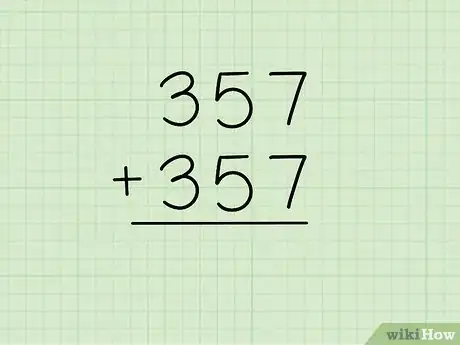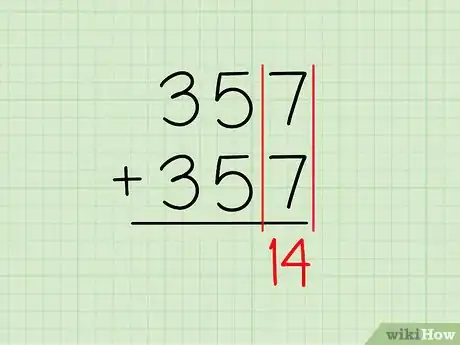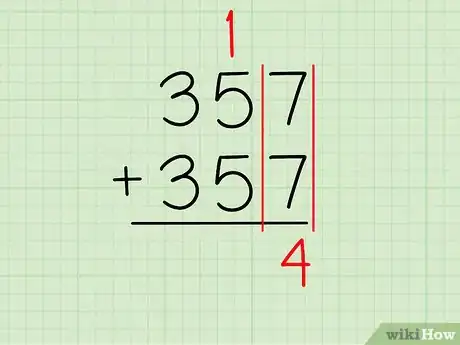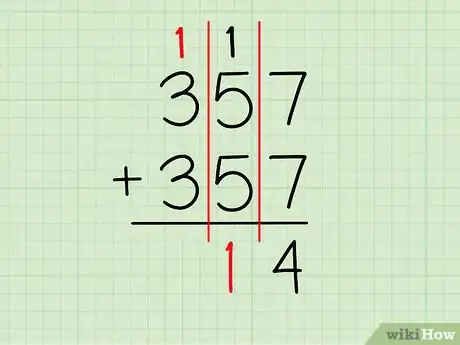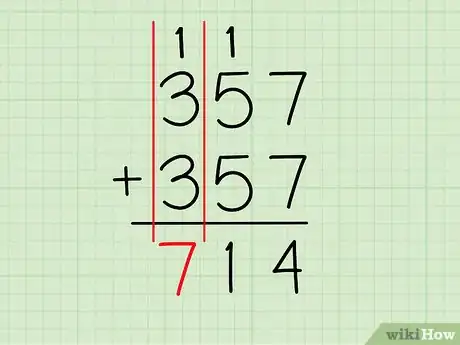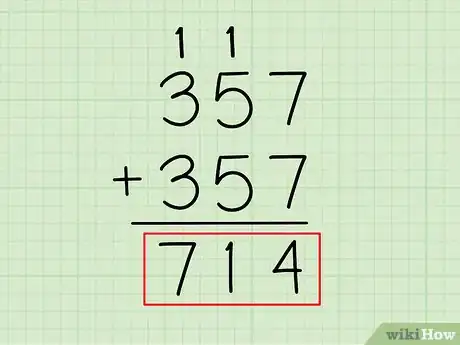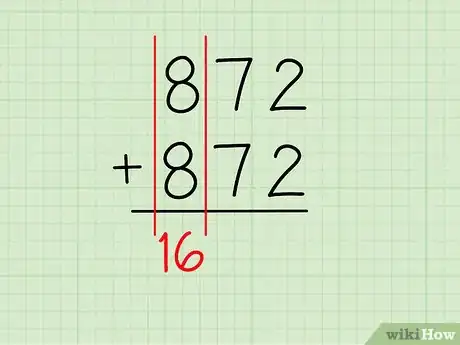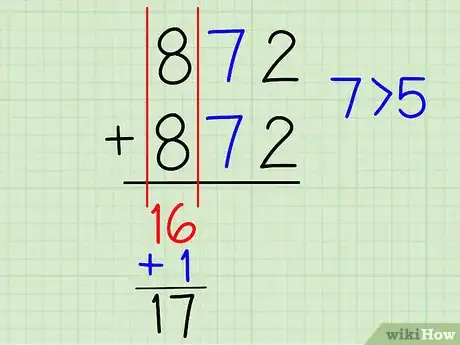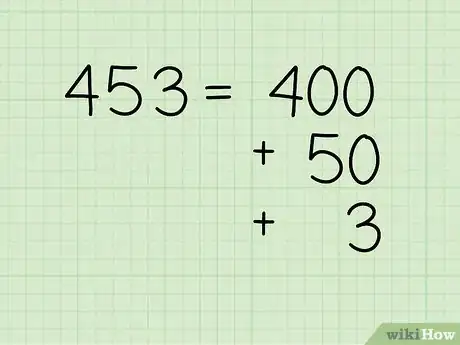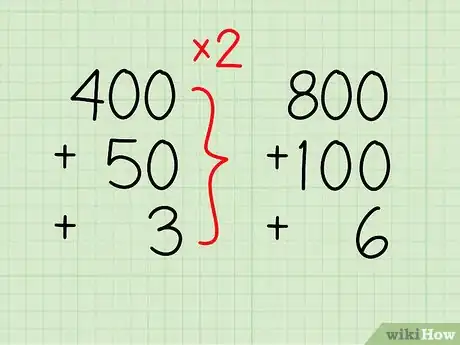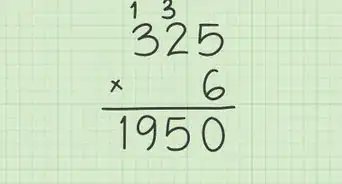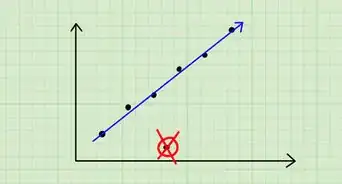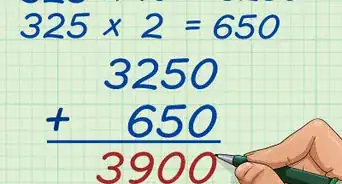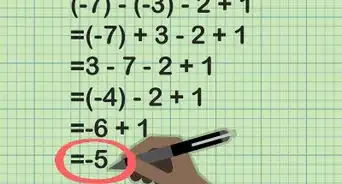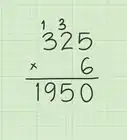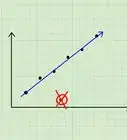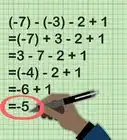X
wikiHow is a “wiki,” similar to Wikipedia, which means that many of our articles are co-written by multiple authors. To create this article, volunteer authors worked to edit and improve it over time.
This article has been viewed 57,936 times.
Learn more...
Doubling large numbers can seem intimidating at first, but the task becomes easier with practice. There are multiple methods you can use to double a number. Learn each method, then use the one that is easiest for you the next time you're faced with a doubling problem.
Steps
Method 1
Method 1 of 3:
Method One: Basic Addition
-
1Write out the problem. For this method, you'll need to write out the problem as any other addition problem. Write the number twice, placing a plus sign in between.
-
Example: Find the double of 357.
- Write the problem as you would write out any other addition problem: 357 + 357
-
Example: Find the double of 357.
-
2Add the numbers on the right. Add the right-hand digits of both written values together. Essentially, you are simply doubling the right-hand digit.[1]
-
Example: For 357 + 357, the number on the right is 7.
- 7 + 7 = 14
Advertisement -
Example: For 357 + 357, the number on the right is 7.
-
3Carry any digit greater than 10 to the left. If the sum of the right-hand digits is 10 or greater, you will need to carry the value in the “tens” place position over to the next set of digits. Only write the number in the “ones” place position as part of your answer.[2]
- Example: In this problem, 14 is greater than 10, so the you must carry the 1 over to the next place setting. The 4 will be the right-most digit in your answer.
-
4Add the next set of numbers. Add the next set of digits together, moving to the left. If you carried over a “1” from the previous place setting, you should add that to the two digits, as well.
-
Example: For 357 + 357, the next digit to the left is 5.
- Since you carried over 1 from the previous place setting, you must also add it to the doubled value of this place setting.
- 5 + 5 + 1 = 11
-
Example: For 357 + 357, the next digit to the left is 5.
-
5Repeat until you reach the end of the line. Continue through the rest of the number in the same manner, working from right to left, until you reach the final set of digits on the left-hand side of the total value.
-
Example: Since 11 is greater than 10, you will need to carry the extra 1 over to the next place setting. The right-hand 1 will be the middle digit in your answer.
- There is only one place setting left to deal with in this answer. You will need to add the values of this place setting together along with the 1 you carried over: 3 + 3 + 1 = 7
- This 7 will be the left-most digit in your answer.
-
Example: Since 11 is greater than 10, you will need to carry the extra 1 over to the next place setting. The right-hand 1 will be the middle digit in your answer.
-
6Write the final answer. If you haven't done so already, write the calculated sums from each place position side-by-side. This answer should be the doubled amount of your original number.
-
Example: The left-most digit is 7. The middle digit is 1. The right-most digit is 4. When written together, the answer is '714.
- Therefore, the double of 357 is 714.
-
Example: The left-most digit is 7. The middle digit is 1. The right-most digit is 4. When written together, the answer is '714.
Advertisement
Method 2
Method 2 of 3:
Method Two: Double by Line
-
1Double the left digit. Look at the first digit of the number (the one on the left, with the highest place value). Mentally double that digit and write it down. The answer will be the first one or two digits of your final answer.
-
Example: Find the double of 872.
- The left digit is 8.
- The double of 8 is 16.
-
Example: Find the double of 872.
-
2Look at the second digit. If the second digit to the right is 5 or greater, you will need to add 1 to the value calculated in the previous step.[3]
- If the second digit is below 5, you do not need to add anything else to the previous value.
- Doubling any digit between 5 and 9 will result in a two digit number, which makes this step necessary. Doubling and digit between 0 and 4 will result in a single digit number.
-
Example: The second digit in 872 is 7. Since 7 is greater than 5, you need to add 1 to the sum of the previous place value.
- 16 + 1 = 17
- This means that your final answer will begin with 17.
-
3Double the second digit. Return to the second digit and double it. This value will be the next digit in your final answer.[4]
- If the value calculated in this step is two digits, ignore the digit in the tens place and only write down the digit in the ones place.
-
Example: The second digit of 872 is 7.
- The double of 7 is 14.
- Ignore the tens place (1) and only save the value of the ones place (4) for your final answer.
- This 4 will appear in the middle of your final answer.
-
4Repeat toward the right. Continue through the rest of the digits in the same manner, moving from left to right, until you double the final digit in the “ones” place value.
-
Example: For this problem, there is only one more place value to work with.
- The final digit of 872 is 2. Since 2 is less than 5, you do not need to add anything more to the sum of the middle place value.
- The double of 2 is 4. This will be the final digit in your answer.
-
Example: For this problem, there is only one more place value to work with.
-
5Write it out. Write all of the calculated values of each place position side by side. This should be your final answer.
-
Example: The first part of the answer is 17. The middle digit is 4. The final digit is 4. When written together, that gives you an answer of 1744.
- Therefore, the double of 872 is 1744.
-
Example: The first part of the answer is 17. The middle digit is 4. The final digit is 4. When written together, that gives you an answer of 1744.
Advertisement
Method 3
Method 3 of 3:
Method Three: Double by Partition
-
1Separate the number into pieces. Partition or decompose the number into its separate place value pieces: ones, tens, hundreds, and so on. Write it out in extended form.[5]
-
Example: Find the double of 453.
- When broken apart into separate place values: 453 = 400 + 50 + 3
-
Example: Find the double of 453.
-
2Double each part. Look at each partitioned portion and double it while separated.[6]
- To double values larger than those in the ones place position, double the non-zero digit, then follow that calculated value with the same number of zeroes.
-
Example: You will need to double 400, 50, and 3 separately.
- Since the double of 4 is 8, the double of 400 is 800.
- Since the double of 5 is 10, the double of 50 is 100.
- The double of 3 is 6.
-
3Add the pieces together. Add the doubled values together to write the answer in its standard form.
- Example: 800 + 100 + 6 = 906
-
4Write the answer. The answer you found by adding the doubled values together should be the doubled value of your original number, and your final answer.
- Example: The double of 453 is 906.
Advertisement
Community Q&A
-
QuestionMy 1st grader has home work and it asks him what numbers double to make 9. They are not using decimals yet so what could it be?
 Community AnswerYou could just say 4 and a half. It's the same thing as 4.5 and it isn't a decimal.
Community AnswerYou could just say 4 and a half. It's the same thing as 4.5 and it isn't a decimal.
Advertisement
References
- ↑ https://www.mathsisfun.com/numbers/addition-column.html
- ↑ https://www.mathsisfun.com/numbers/addition-column.html
- ↑ https://www.khanacademy.org/math/arithmetic-home/addition-subtraction/basic-add-subtract/v/basic-addition
- ↑ https://www.khanacademy.org/math/cc-fourth-grade-math/multiplying-by-2-digit-numbers/multiply-2-digit-numbers-with-partial-products/e/multiplication_3
- ↑ https://www.youtube.com/watch?v=zR1_RSh0sgU
- ↑ https://www.youtube.com/watch?v=zR1_RSh0sgU
About This Article
Advertisement
